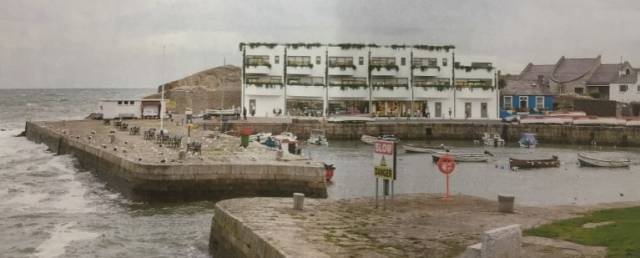#BullochHarbour - Concerned residents and marine users of Bulloch Harbour, Dalkey, Co. Dublin are to hold a public meeting tomorrow (Thurs. Jan.5th) over a proposed mixed development at a sensitive coastal site of the former premises of Western Marine, writes Jehan Ashmore.
Afloat last reported just before Christmas of the proposed development by Bartra Property that acquired the site of the chandlery business that are to relocate locally. The site is fronting the quayside of the scenic Dublin Bay harbour. It is one of the last working harbours in the bay with fishing boats, is popular for marine leisure activities and as a tourist attraction in the salubrious southside suburb.
Last month the developer lodged a planning application to seek permission to demolish the single-storey warehouse (1,210 sq m) and replace with the construction of several structures totalling (2,324 sq m) and each of these buildings of three-storeys in height. Click for previous report / image here. According to Save Bulloch Harbour facebook page a public meeting is to be held tomorrow to discuss the development at the Fitzpatrick Hotel, Killiney, Thursday at 7.30pm.
The meeting organisers, Bulloch Harbour Preservation Association whose members include boat users, Dalkey Sea Scouts, Dalkey Community Council and Tidy Towns have raised strong concerns on the proposed redevelopment. The Association claims the proposed development given on grounds of scale, height and bulk will adversely impact and destroy the unique heritage character of the historic harbour that has its origins dating to the 12th century.
Part of the proposed development is a block comprising of two and three stories high containing seven commercial units for marine businesses at ground floor level along the quayside. One of the marine units would be set aside for a café. In addition to six residential apartment units (each of around 1,660 sq ft) at ground floor to the rear and first and second floor overhead. The design of the apartments would feature balconies and roof gardens overlooking the harbour.
In addition at the rear of the former marine chandlery boat storage yard are proposed three houses (each up to 4,800 sq ft). Likewsise of the mixed development block, these dwellings are three-storeys high along with roof terraces. These residential units would exceed the height of the mixed block fronting the harbour built of Dalkey granite. Such cargoes from local quarries were shipped across the bay to assist the Ballast Board in the construction of Dublin Port during the 19th century.
In planning permission documents lodged by Bartra Property to the planning office of Dun Laoghaire-Rathdown County Council, the developers cite in their Planners Report that the brownfield site at Bulloch Harbour, is under the county development Plan 2016-2022. The lands at Bulluch Harbour are zoned with Objective W ‘to provide for waterfront development and harbour related uses’. The developer claims the café along the waterfront will enhance the amenity of the quayside.

























